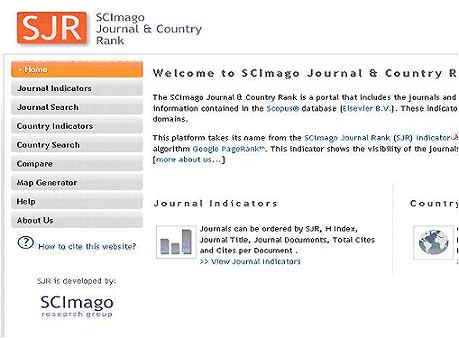SCImago on:
[Wikipedia]
[Google]
[Amazon]
 The SCImago Journal Rank (SJR) indicator is a measure of the prestige of scholarly journals that accounts for both the number of citations received by a journal and the prestige of the journals where the citations come from.
The SCImago Journal Rank (SJR) indicator is a measure of the prestige of scholarly journals that accounts for both the number of citations received by a journal and the prestige of the journals where the citations come from.
Network-based Citation Metrics: Eigenfactor vs. SJR.
{{DEFAULTSORT:Scimago journal rank Academic publishing Journal ranking Citation indices
Rationale
Citations are an indicator of popularity of scientific works and can be perceived as endorsement; prestige can be understood as a combination of the number of endorsements and the prestige of the works publishing them. Adopting this view, the ''SJR indicator'' assigns different values to citations depending on the perceived prestige of the journals where they come from. However, studies of methodological quality and reliability have found that "reliability of published research works in several fields may be decreasing with increasing journal rank", contrary to widespread expectations. The calculation of the ''SJR indicator'' is similar to the '' Eigenfactor score'', with the former being based on theScopus
Scopus is Elsevier's abstract and citation database launched in 2004. Scopus covers nearly 36,377 titles (22,794 active titles and 13,583 inactive titles) from approximately 11,678 publishers, of which 34,346 are peer-reviewed journals in top-l ...
database and the latter on the Web of Science database, and there are other differences.
Computation
A journal's SJR indicator is a numeric value representing the average number of weighted citations received during a selected year per document published in that journal during the previous three years, as indexed byScopus
Scopus is Elsevier's abstract and citation database launched in 2004. Scopus covers nearly 36,377 titles (22,794 active titles and 13,583 inactive titles) from approximately 11,678 publishers, of which 34,346 are peer-reviewed journals in top-l ...
. Higher SJR indicator values are meant to indicate greater journal prestige.
SJR is developed by the Scimago Lab, originated from a research group at the University of Granada.
The SJR indicator is a variant of the eigenvector centrality measure used in network theory. Such measures establish the importance of a node in a network based on the principle that connections to high-scoring nodes contribute more to the score of the node. The SJR indicator has been developed to be used in extremely large and heterogeneous journal citation networks. It is a size-independent indicator and its values order journals by their "average prestige per article" and can be used for journal comparisons in science evaluation processes. The SJR indicator is a free journal metric inspired by, and using an algorithm similar to, PageRank
PageRank (PR) is an algorithm used by Google Search to rank webpages, web pages in their search engine results. It is named after both the term "web page" and co-founder Larry Page. PageRank is a way of measuring the importance of website pages. A ...
.
The SJR indicator computation is carried out using an iterative algorithm
In mathematics and computer science, an algorithm () is a finite sequence of rigorous instructions, typically used to solve a class of specific problems or to perform a computation. Algorithms are used as specifications for performing ...
that distributes prestige values among the journals until a steady-state solution is reached. The SJR algorithm begins by setting an identical amount of prestige to each journal, then using an iterative procedure, this prestige is redistributed in a process where journals transfer their achieved prestige to each other through citations. The process ends up when the difference between journal prestige values in consecutive iterations do not reach a minimum threshold value any more. The process is developed in two phases, (a) the computation of ''Prestige SJR'' (''PSJR'') for each journal: a size-dependent measure that reflects the whole journal prestige, and (b) the normalization of this measure to achieve a size-independent measure of prestige, the ''SJR indicator''.
In addition to the network-based SJR indicator, the SJR also provides a more direct alternative to the impact factor
The impact factor (IF) or journal impact factor (JIF) of an academic journal is a scientometric index calculated by Clarivate that reflects the yearly mean number of citations of articles published in the last two years in a given journal, as ...
(IF), in the form of average citations per document in a 2-year period, abbreviated as ''Cites per Doc. (2y)''.
See also
*Journal-level metrics
Journal ranking is widely used in academic circles in the evaluation of an academic journal's impact and quality. Journal rankings are intended to reflect the place of a journal within its field, the relative difficulty of being published in that ...
* CiteScore
*''Journal Citation Reports
''Journal Citation Reports'' (''JCR'') is an annual publicationby Clarivate Analytics (previously the intellectual property of Thomson Reuters). It has been integrated with the Web of Science and is accessed from the Web of Science-Core Collec ...
''
* Journalology
*Impact factor
The impact factor (IF) or journal impact factor (JIF) of an academic journal is a scientometric index calculated by Clarivate that reflects the yearly mean number of citations of articles published in the last two years in a given journal, as ...
References
External links
* * A "description, in plain English" oNetwork-based Citation Metrics: Eigenfactor vs. SJR.
{{DEFAULTSORT:Scimago journal rank Academic publishing Journal ranking Citation indices